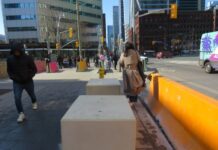Implementing a project that provides convenient and efficient connectivity to the rest of the city was one of the key aspects of Amexon’s approach to developing their master plan community, The Residences at Central Park. Marketed as a forward-thinking community offering the rare blend of natural amenities and urban conditions, the project’s location on the edge of the East Don Parkland Gorge adjacent to TTC’s Leslie station on the 4 Sheppard Line has enabled that promise. But even in these unique conditions, there was an additional consideration that had the potential to add another dimension to the site: the inclusion of GO Transit’s Oriole Station.
Looking back on some of our previous coverage of The Residences at Central Park, the presence of Oriole Station on the southwest corner of the 12-acre mixed-use development was described as another aspect that adds to the project’s list of amenities. However, anyone who has ridden GO Transit’s Richmond Hill Line knows that Oriole Station is actually about half a mile south — at least for now. Metrolinx plans have already been submitted to the city, detailing a strategy for moving the station permanently, creating a more seamless connection with Leslie Station and, of course, placing it on Central Park’s doorstep.
Looking northeast at the complete design for The Residences at Central Park, image courtesy of Amexon
In its current state, Oriole Station’s main entrance is accessible south of Highway 401 on the west side of Leslie Street. The platform extends under the freeway, with a pedestrian walkway at its northern end providing commuters a route to Esther Shiner Boulevard, 200 meters from Leslie Station. The lack of a more convenient connection between the two stations is the main driver behind the relocation project, but after nearly 20 years of deliberation, the addition of Central Park may have given the project the boost it needs to move forward.
The map view shows the location of the current Oriole station (blue) and Leslie station (red), image from Apple Maps
The new station will be built on the north side of the highway with its main entrance on the south side of Sheppard Avenue just west of Leslie Station. However, the platform will continue to extend north, crossing Sheppard Avenue and terminating on the north side of the street, right at the southwest corner of the Central Park lot. The image below shows the concept of how the move will come together, with Central Park on the right half of the image and the main station entrance on the left, just behind the Leslie Station bus terminal.
Concept design for a relocated train station with access from Central Park, image courtesy of Amexon
Meanwhile, a series of renderings included in Metrolinx’s submission to the city sheds light on some of the details of the new station’s design. While the renderings are a bit rudimentary, we can get a sense of the overall thrust, which is similar to UP Express stations, with black finishes and modern boxy bulk.
Design for the entrance to the relocated Oriole GO station, image from submission to the City of Toronto
In addition, the plans indicate that the platform will feature a long canopy structure that will provide more robust wind protection, particularly on the section that spans Sheppard Avenue.
The relocated platform extends north across Sheppard Avenue, image from filing with the City of Toronto
The project is awaiting final city approval and will likely coincide with the construction plan for the first phase of Central Park, which is expected to break ground later this year.
UrbanToronto will continue to monitor the progress of this development, but in the meantime you can learn more from our database file linked below. If you wish, you can join the discussion in the dedicated project forum thread or leave a comment in the space provided on this page.
* * *
UrbanToronto has a research service, UrbanToronto Pro, that provides comprehensive data on metro Toronto development projects from concept to completion. We also offer instant reports, downloadable snapshots based on location, and a daily subscription newsletter, New Development Insider, that follows projects from the first application.

















